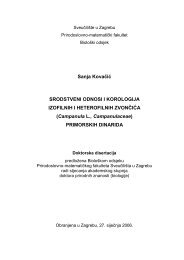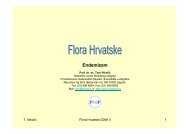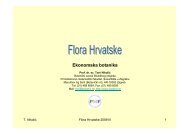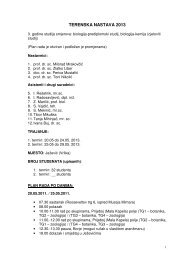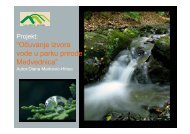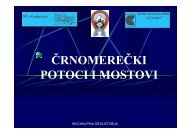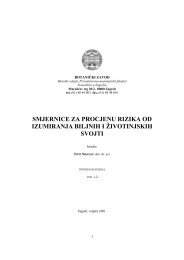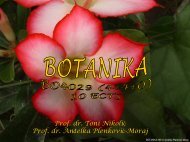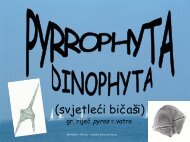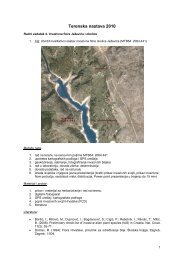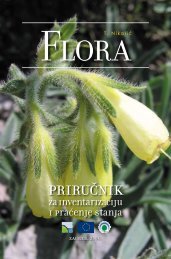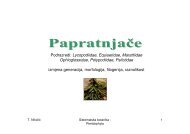important plant areas in central and eastern europe - hirc.botanic.hr ...
important plant areas in central and eastern europe - hirc.botanic.hr ...
important plant areas in central and eastern europe - hirc.botanic.hr ...
You also want an ePaper? Increase the reach of your titles
YUMPU automatically turns print PDFs into web optimized ePapers that Google loves.
RussiaJONATHAN RUDGEOngo<strong>in</strong>g workBelarus The IPA project <strong>in</strong> Belarus is the first practical project <strong>in</strong> the region <strong>and</strong> hasdemonstrated the need for fieldwork <strong>in</strong> validat<strong>in</strong>g data, the need to develop regionallyrelevant species <strong>and</strong> habitats lists, <strong>and</strong> the value of regional teams for develop<strong>in</strong>g theproject <strong>in</strong> different countries. (see Belarus section above for details)Russia IUCN-CIS has dissem<strong>in</strong>ated Russian-language materials <strong>and</strong> <strong>in</strong>formation <strong>and</strong> theRussian national network of specialists, protected area managers <strong>and</strong> governmentrepresentatives, cont<strong>in</strong>ues to <strong>in</strong>crease.IUCN-CIS is work<strong>in</strong>g on a study of the rare <strong>and</strong> t<strong>hr</strong>eatened species of European Russia,which illustrates the need to update global <strong>and</strong> regional <strong>plant</strong> conservation lists with thelatest <strong>in</strong>formation from Russia. Of the 273 species listed <strong>in</strong> the Red Data Book for theEuropean part of Russia, which <strong>in</strong>cludes 125 endemic or near-endemic species, only 81of these were <strong>in</strong>cluded <strong>in</strong> the Global Red List (1997) <strong>and</strong> only 15 species are <strong>in</strong>cluded <strong>in</strong>the Bern Convention.This study also illustrated that only 32% of Russia’s rare speciesare conserved <strong>in</strong> strictly protected <strong>areas</strong> such as Zapovedniks.References:Plantlife International 2002, Identify<strong>in</strong>gImportant Plant Areas <strong>in</strong> Europe.Russian language edition published byIUCN-CISDem<strong>in</strong>a O., 2004 The East Europe steppesof Russia <strong>and</strong> the preservation of flora.Presentation at Planta Europa IVConference (www.nerium.net/<strong>plant</strong>aeuropa/Submissions.htm)IUCN for Russia <strong>and</strong> CIS, & the Institutefor Experimental Botany M<strong>in</strong>sk, 2004,Important Plant Areas <strong>in</strong> Belarus.IUCN-CIS (In Russian)IUCN for Russia <strong>and</strong> CIS, 2004Important Plant Areas <strong>in</strong> EuropeanRussia. IUCN-CIS (In Russian)IUCN for Russia & CIS, 2004 ImportantPlant Areas <strong>in</strong> Northern EurasiaVol.1. IUCN-CIS (In Russian)Kazakova M., 2004 Ecosystem approach toImportant Plant Area Protection: an examplefrom Russia. Presentation at Planta EuropaIV Conference (www.nerium.net/<strong>plant</strong>aeuropa/Submissions.htm)Planta Europa & the Council of Europe,2002 European Strategy for PlantConservation. Russian language editionpublished by IUCN-CISSmelansky, I.; Korolyuk ,A. & Artemov, I.2004. Protection of steppe communities<strong>and</strong> <strong>plant</strong> conservation: a case of oneRussian territory. Planta Europa IVProceed<strong>in</strong>gs. (www.nerium.net/<strong>plant</strong>aeuropa/Download/Proced<strong>in</strong>gs)Forest steppe <strong>in</strong> Siberian RussiaVarlyg<strong>in</strong>a T., Pronk<strong>in</strong>a G., 2004 ImportantPlant Areas <strong>in</strong> European Russia –Approaches to Identification. PlantaEuropa IV Proceed<strong>in</strong>gs.(www.nerium.net/<strong>plant</strong>aeuropa/Download/Proced<strong>in</strong>gs)Krasnaja Kniga RSFSR. Rastenija.. M.,Rosagropromizdat, 1988. 592 s. (Red DataBook of the RSFSR. Plants/ – Moscow,1988. – 592 pp..The Present-day State of Biodiversitywith<strong>in</strong> Protected Areas of Russia. Issue 2.Vascular Plants (<strong>in</strong> 2 parts) – Moscow,2003. – 784 pp.1997 IUCN Red List of T<strong>hr</strong>eatened Plants.– IUCN, 1998. – 862 p.57



